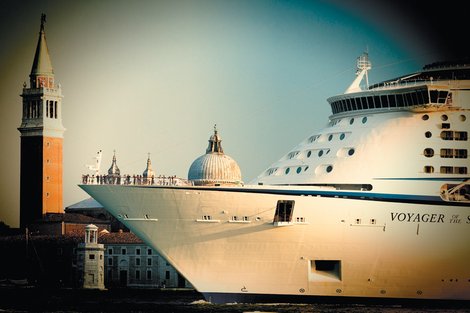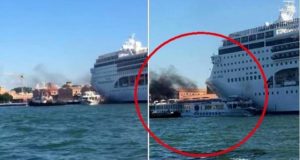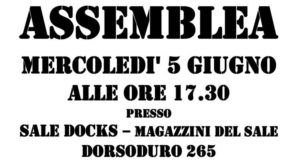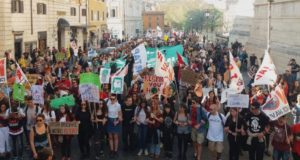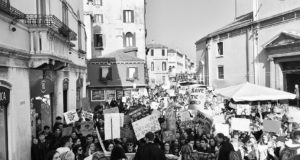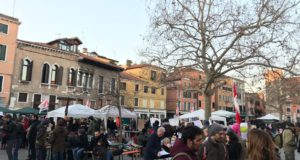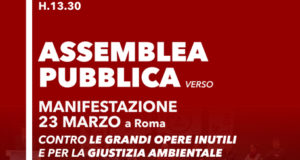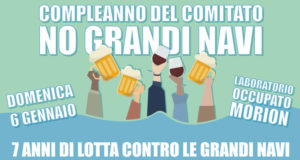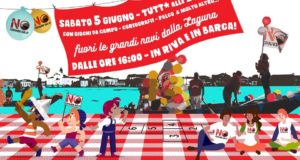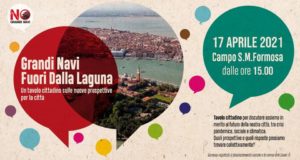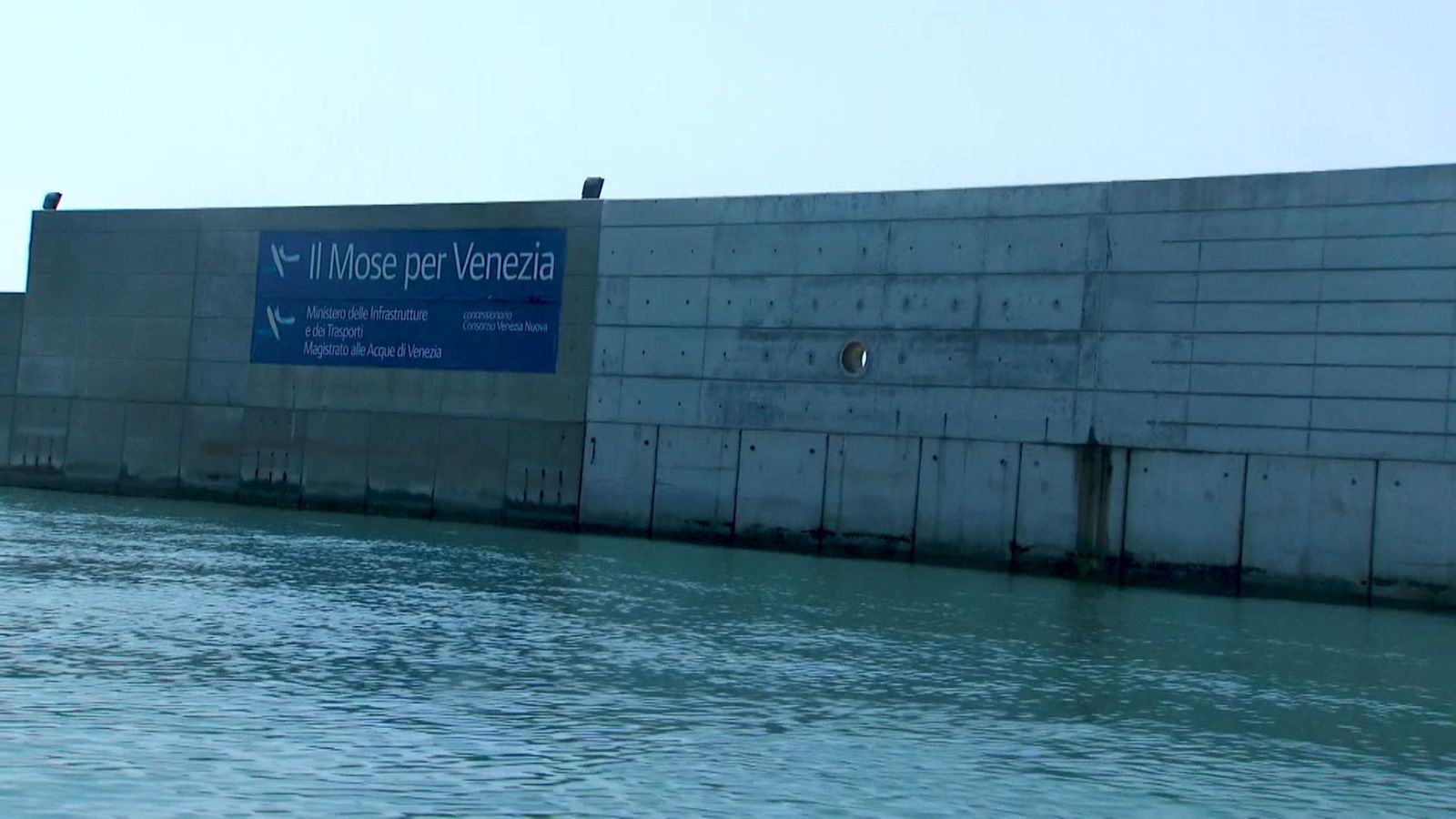Fortunately, the €1.5 billion investment will probably not be found, but if it is, the City Council of Venice will be giving permission in July for an 820-foot-high skyscraper (130 feet taller than the Tour Montparnasse in Paris) to be built on the mainland behind Venice, about six miles from St. Mark’s Square.
The mayor, Giorgio Orsoni, assures us that the building will not spoil the skyline of Venice, but The Art Newspaper, of which I am the founding editor, published a photomontage based on calculations of what it would look like from the Lido, the strip of land opposite St. Mark’s Square separating the lagoon from the Adriatic. The skyscraper looms up, two thirds the height of the campanile of St. Mark’s, and would ruin the iconic (appropriate use of the word here) view that we all have in our mind’s eye.
Not true, insisted the mayor. So I asked the consulting firm Millerhare, which does this kind of projection for all big buildings in London, to go over the calculations. Like so many people, especially outside Venice, they love the city, so they donated their expertise. Their findings confirmed ours.
What is going on here? The answer is that over the last thirty years Venice has become the object of so much politicized wrangling, in which the truth has been the first victim, that an arithmetical fact can be treated as a matter of opinion and most people will just shrug their shoulders. This attitude lies behind much of what is described in this article and is putting the city at risk.
In 1987, Venice was declared a UNESCO World Heritage Site, at which point it was supposed to come up with a management plan. This March, the City Council finally presented it to the public. Its purpose, the council said, was to “define the strategies and choose the ways of putting them into practice through action plans.” Unfortunately, the document fails almost completely in both these objectives because its authors have funked all the big issues.
Being a World Heritage Site is not an accolade spontaneously awarded byUNESCO, but something that requires an application to be made by a nation-state. Italy asked for Venice to be put on the list. Not surprisingly, the city was found to fulfill all the necessary criteria, and in exchange for the title, Italy signed up to produce a management plan and define a “buffer zone” around Venice. Being a World Heritage Site does not guarantee any funding because UNESCO has a mere $3.25 million to spend on its activities and on all heritage sites this year (besides $4.5 million for its offices and $7.5 million for specific projects, including Mali).
The most UNESCO can hope to do is keep watch, and if it sees gross abuse of a site it can protest, make formal representations to the nation involved, put the place on its List of World Heritage in Danger, and, as a last resort, strip it of its title. There is a great deal of diplomatic and political reluctance to do this, so it has only ever happened twice. There is a UNESCO office in Venice, but it is not for Venice. Its purpose is to provide scientific and cultural expertise to Southeast Europe, although one member of its staff is assigned to administer the money contributed for restoration projects by charities such as the World Monuments Fund, Save Venice, Venice Heritage, and the Venice in Peril Fund (of which I was chairman from 2000 to 2012). In other words, if the UNESCO office in Venice sees abuse of the city’s World Heritage status it cannot do anything about it except send a report to the department in Paris that runs the World Heritage scheme.
In 2006, the Italian government decreed that all Italian World Heritage Sites should produce their management plans, and in November 2012, the plan for Venice was finally approved by the City Council, which had been appointed to compile it and be the official respondent to the state and UNESCO in 2007 by the twenty bodies—governmental, regional, and civic—that have a say in the running of Venice and its lagoon.
It is a 157-page document, based, it says, on the consultation of 250 public bodies, with 136 resulting proposals. Which these were is not revealed, but I have discovered that the very popular “No Big Ships” movement was not consulted. It is not difficult, however, to deduce that the City Council did listen to the Venice Port Authority, since the question of the vast cruise ships sailing through town is barely mentioned among the list of problems to be resolved. Although the plan suggests that studies be undertaken of the port’s activities and the cruise ships from an environmental and socioeconomic point of view, it says they must fit in with the port’s objectives of “developing the port of Venice as part of the historic, economic, and social heritage of Venice and its lagoon.”
I know where that phrase comes from. I heard the powerful head of the Venice Port Authority (VPA), Paolo Costa, say exactly that in a speech to the annual general meeting of the Association of Private Committees for the Safeguarding of Venice in October 2011. He is proud of the fact that, under his management, the port in Venice has risen to be the most important in the Mediterranean for the cruising industry. On any given day now, except in the winter, you will see these vast white floating hotels, thirteen or fifteen decks high, towering over the ancient rooftops and steeples, being pulled by tugs toward the Doge’s Palace, then turning starboard down the Giudecca Canal. Most are over three times the length of an American football field, with gross tonnage of 100,000 or more (the Titanic was only 46,000 tons). In 1997 there were 206 cruise ships, in 2011, 655, and because they sail into and out of the city by the same canal, that means 1,310 passages—blotting out the view, polluting the air, shaking the houses, and displacing water up into the canals off the Giudecca.
Politically speaking, Costa has more guns than Mayor Orsoni, who is just a lawyer. Costa, on the other hand, has been minister of public works—always a powerful position—in the national government, president of the EU Parliament’s Committee on Transport and Tourism, and last year he was reconfirmed as head of the VPA until 2016. He thinks big and has plans to turn the port at Marghera on the mainland edge of the lagoon into a transport hub for merchandise on the planned EU east–west transport axis from Barcelona via Venice into the Balkans and Ukraine. The Venice-Marghera port would become the biggest in northern Italy, with goods coming up the Adriatic to Venice and fanning out from there by road and rail. But the scheme depends on EU funding, and while the passenger port within Venice may be small by comparison, it has the advantage from Costa’s point of view of being entirely under his control, so he is able to make things happen.
Since 1997 the VPA has put €141 million into adapting and modernizing the passenger port, while the company it set up that year to manage the port, Venezia Terminal Passeggeri, has contributed €32 million. SAVE, the company that manages the Venice airport, is a shareholder in VPA and has an interest in the growth of the port because most of the cruise passengers arrive or depart by air. The City Council, on the other hand, has no shares in VPA or SAVE and no direct say whatever in how they are managed. It does not even have any authority over the Giudecca Canal down which the ships sail, because, unlike all the other canals in Venice, the Giudecca comes under the VPA. It is as though Broadway were not Mayor Bloomberg’s preserve but that of the federal Department of Transportation.
The number of berths in the Venice port has been increased so that it can now take eight ships at a time, and starting later this year they will all be big ones since the smaller ferry boats to Greece will be docking on the mainland side of the lagoon. The new facilities there have been a €250 million project, which shows that Costa is good at getting money, helped in this case by the fact that these docks are in an area of dying petrochemical industry, which central and local governments need to see cleaned up and converted to some other activity. And where there is construction, money flows, jobs are created, votes are won. So that is where the power lies—not with the impecunious City Council and mayor.
Costa denies that the passage of the ships affects either the buildings or the quality of the air, but opponents say that no truly independent studies have been carried out. What is certain, though, is that the 200,000 cruise tourists embarking in Venice in 1990 became 337,000 in 2000, one million in 2007, and reached 1.8 million in 2011. Silvio Testa, who leads the vociferous No Big Ships campaigners (they have lined the banks of the Giudecca Canal with long banners informing the passengers leaning over the rails how fed up they are), told me that on just one day in July 2011, six of these ships tied up in port and 35,000 tourists were disgorged all at once.
After the Costa Concordia ran aground on the island of Giglio on January 13, 2012, Francesco Bandarin, UNESCO’s assistant director-general for culture, wrote a letter to the Italian Ministry of the Environment saying that this accident reinforced “longstanding concern” over the risk posed to World Heritage Sites, and Venice and its lagoon in particular. A government decree shortly afterward banned ships of more than 40,000 tons from sailing down the Giudecca Canal. This decree has been ignored.
Yet despite this decree and the formal appeal by a senior member of UNESCO, despite the fact that the City Council was writing the management plan forUNESCO, despite being responsible for a UNESCO World Heritage Site, the authors of the plan could not muster enough courage to let out the smallest squeak against the interests of the VPA. I asked Giorgio de Vettor, one of the coordinators of the plan, why the cruise ships were not mentioned, and was not surprised, except by his candor, when he just said, “You understand the reason.”
So what is going to happen with the cruise ships? There is no doubt that the port plays a growing part in the city’s economy. According to Costa, it provides 1,600 direct jobs in services for the ships and passengers, 2,600 jobs in supplies, maintenance, repairs, bunker sales, etc., and 1,270 direct jobs created by tourist spending in Venice (at least €363 million a year) before and after the cruise, with one third of passengers disembarking and embarking there.
These are impressive considerations in a town where there are fewer and fewer jobs outside the tourist industry. But nothing is revealed about what the port contributes directly to the running costs of the city and who benefits from its profits. As so often in Venice, information is lacking or withheld, given grudgingly, or used as propaganda.
After having invested so much, the last thing Costa wants is for the cruise ships to dock anywhere else, yet he himself admits that “what they awaken in most people is fear and concern,” so he suggests a way of reducing the number of sailings through the city by deep-dredging an existing shallow channel through the lagoon called the Calle Contorta di Sant’Andrea so that the ships can either come down the Giudecca Canal and then sail out by this new route (his preferred option) or avoid the center of Venice altogether and come both in and out by the Calle Contorta. But the view from there is of the petrochemical works, so tourists who had expected to feast their eyes on the Doge’s Palace and St. Mark’s Square might well feel cheated, and this could be bad for business. However, since it is very unlikely that the ecologists will allow the Calle Contorta to be deep-dredged, Costa is probably not too worried.
Another local politician has come up with a plan for a new, relatively inexpensive dock capable of berthing up to eight ships, to be built within the huge, existing breakwater at the Lido opening; passengers would be brought into town by catamarans that would hardly disturb the waters. But at a cost of €200 million this is unlikely to happen soon because Italy is broke. So expect to go on seeing the cruise ships in Venice. (…)
 Comitato No grandi navi Comitato No grandi navi – Laguna bene comune
Comitato No grandi navi Comitato No grandi navi – Laguna bene comune

